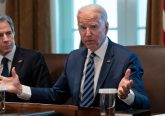The recent confirmation of Mike Pompeo as Secretary of State by the Senate symbolizes that nationalist “hawks” dominate the Republican Party’s foreign policy. Even the famously non-interventionist Republican Senator Rand Paul supported his nomination. Pompeo’s quick and frictionless confirmation points to a shift to the right in what constitutes “common-sense” in US foreign policy. However, as this article will argue such changes in US foreign policy have predated Pompeo’s nomination and even President Trump’s election.
Mike Pompeo, who came to Congress with the Tea Party movement in 2010, is an interventionist of the America-First variety. He desires strong sanctions on North Korea, Iran and Russia, supports extra-legal military strikes in areas of jihadist activity, and deeply distrusts China’s economic and military rise. For him, the United Nations, nation-building, democracy promotion and human rights are lesser priorities.
Pompeo replaces Rex Tillerson who has been considered more moderate on issues of foreign intervention, the Iran nuclear deal and climate change. With the concurrent replacement of National Security Advisor HR McMaster by foreign policy “hawk” John Bolton this leaves the “moderate wing” of the Trump administration reduced to Defense Secretary General Jim Mattis. This is the same “mad dog” Mattis that was regarded as too hawkish for the Obama Administration.
While the recent change of principal characters in US foreign policy suggests a sea-change, this has arguably been a gradual rising of the waters rather than a spring flood. Despite initially campaigning on his opposition to the Iraq war, winning the Nobel Peace Prize and signing the Iran nuclear deal, President Obama was no foreign policy “dove.” Obama’s drone program and extra-legal special forces deployment in Somalia, Yemen, Pakistan, Syria, Iraq and West Africa and the 2009 surge in Afghanistan were too hawkish for many left-wing Democratic voters.
In many ways, the Obama administration evidenced continuity rather than change in its foreign policy from the Bush years. The “common-sense” of a highly militaristic US foreign policy solidified under Obama at a time when technology on surveillance, robotics and drones was rapidly advancing. Military solutions in zero-sum power games were no longer just the domain of the Republican Party.
Indeed, it is possible to find some of the “realist” traits of Trump’s “America First” already in the Obama years. There was a clear desire not to get involved in foreign entanglements in Syria, to take a less prominent role in Libya, and to keep warfare airborne or rely on special forces. Obama, like Trump, pressured European nations to maintain their military spending, and for them to take a lead in military problems closer to their borders, as in Libya. Neither have been interested in nation-building. Undoubtedly influenced by the experience of the Iraq war and occupation but also influenced by the “war on terror” he inherited, Obama pursued an eclectic mix of “pragmatic” rather than “principled” foreign policies.
Traditionally, parts of the Democratic Party had pursued more normative foreign policies with a strong emphasis on human rights, an avoidance of military interventions and reliance of international institutions. For instance, the Carter Administration ended American control of the Panama Canal, and he continued arms control with the Strategic Arms Limitation Talks with the Soviet Union. However, when many Democratic voters switched their allegiances to Reagan in 1980 it was in part due to the Republican Party’s brand of muscular nationalism. At this point the Republican Party came to dominate US foreign policy. The Democratic Party no longer “owned” the debate to construct American foreign policy. For instance, Hilary Clinton was a foreign policy “hawk” much in the mold of most Republican candidates vanquished by Trump in the Republican primaries.
Democrats have been “pushed” rather than “pulled” by Republicans, as they have increasingly and successfully defined the perimeters of “common sense” foreign policy. One clear example is in the Iraq war. The use of force was agreed on by a broad consensus of politicians; from humanitarian-minded Democrats to interventionist “neocon” Republicans. Even today, the debates on Trump’s policy towards North Korea, Iran and China are seen in largely strategic rather than humanitarian terms. Unlike regime change in Iraq, Trump’s America-First policy focuses on reducing US foreign entanglements and expenditure by limiting North Korea’s nuclear program. Freeing the North Korean people from oppression is not on the agenda. Again, the Republican Party is leading the way and deciding what foreign policy debates are about.
Both interventionists and isolationists have coalesced in the Trump administration around the motto of “America First.” After all, there is much Pompeo, Bolton and Trump can agree on: they view international organizations, like the United Nations, as an affront to American sovereignty, they favor militaristic solutions to international problems, and, they scorn foreign aid and the State Department’s diplomatic efforts. This is the Trumpian Republican Party: skeptical of international agreements and with isolationist instincts while wanting to engage with enemies through “tough” talk and short-term military action.
As the Trump administration charts its course with new actors at the helm, such as Pompeo or Bolton, it is important to remember that neither personnel changes nor who occupies the White House necessarily produce radical pendulum swings in foreign policy. A President of either party faces similar limitations and capabilities as his predecessor. Rather than a pendulum swinging widely, we can see foreign policy moving gradually on a continuum. American foreign policy has long put its sovereignty first, whether by not joining the League of Nations, the International Criminal Court or various international treaties on human rights and environmental controls. Clinton did this, as did Bush, and Obama, and now it is Trump’s turn.
Of course, Obama and Trump are characterized by wholly different domestic agendas, political leadership styles and public rhetoric, but they are also both US presidents, who govern the leading economic and military global power, confronted by largely the same foreign policy problems and endowed with the same bureaucratic structures and military capabilities. For all their differences, both face similar international threats and see the military as the main force to address them, highlighting how the perceived choice set or “common sense” has narrowed down, irrespective of who occupies the White House.






